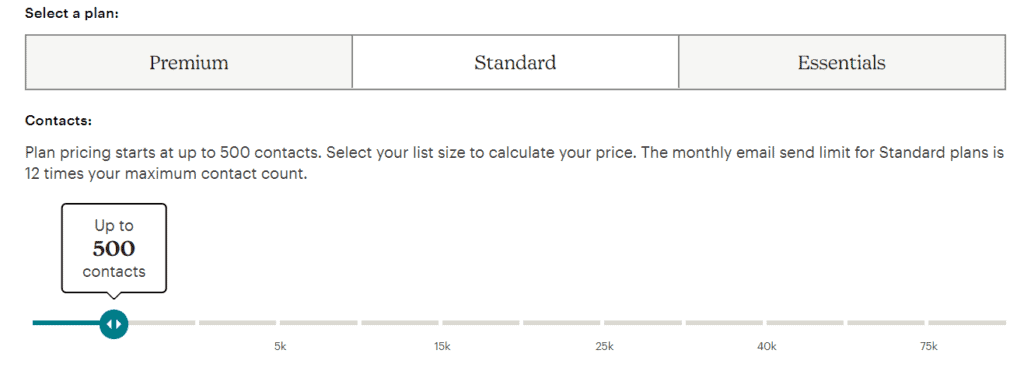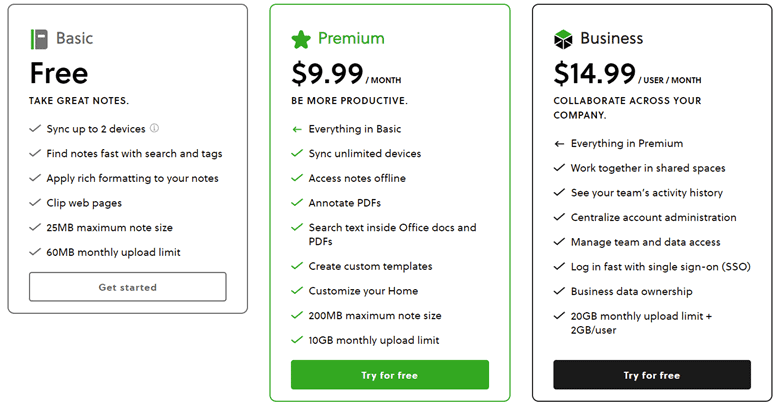Is your SaaS pricing model changing at least every 6 to 9 months? If not, your revenue may not be optimized. After all, nothing affects revenue as much as pricing. With numerous pricing models and strategies to choose from, it can get confusing.
To help you get a better understanding of SaaS pricing strategies, we have created an extensive guide that highlights 6 pricing models you can leverage to boost revenue growth.
The Big 6 SaaS Pricing Models
1) What is Tiered Pricing?
Tiered pricing is the most employed SaaS pricing model. Packages are created based on the needs of each customer segment, usually differentiating based on price and features. This way, you can offer a variety of packages that will appeal to different customer segments.
Example: Chargebee is a subscription billing software that supports end-to-end billing for SaaS businesses. We can see that features are grouped in different tiers and at different prices. This helps Chargebee attract multiple groups of customers, from SMBs to Enterprises.
Why Tiered Pricing Works
- Larger Customer Base: By offering tiers at different price points and features, SaaS companies can attract a wider range of customers.
- Customers Self-Segment: By showing tiers in an easily comparable way, customers will self-segment and purchase the option that resonates with their needs.
- Simple Upgrade Process: Upgrading is easy, as customers know what additional benefits come with a higher tier option.
Drawbacks of Tiered Pricing
- Can Cause Confusion: Studies have shown that customers only consider 3-5 trade-offs when making decisions, thus providing more options may overwhelm the customer and cause a loss in sales.
- You Cannot Please Everyone: As the saying goes, if you try to please everyone, you’ll end up pleasing no one. Focus on your core features to ensure you are not spreading yourself too thin.
- Cannot Capitalize on High Usage: Some customers may use certain features a lot more than the average user, with no way for you to benefit from the potential increase in incremental revenue.
2) What is Per Feature Pricing?
A variation of tiered pricing, per feature pricing defines each tier based on the different features offered. As the number of features increases, so does the price.
Example: Heroku is a resource-based platform as a service that is fully integrated with Salesforce. Heroku makes it easy to deliver engaging apps on the public cloud that integrates with customer data. The rates they charge increase with the number of sophisticated features they offer in each tier.
Why Per Feature Pricing Works
- Easier Sell for Customers: Customers only pay for what they need, thereby increasing the perception that they are getting a ‘deal’.
- Clear Path to Upgrades: The cost and benefits of each feature are transparent, making it clear to the customer what incremental value they receive with each additional feature.
- Addresses Heavy User Risk: Companies can charge more for popular features based on the customer’s willingness to pay, which compensates for the over-usage.
Drawbacks of Per Feature Pricing
- Potentially Wrong Features: It is difficult to fully understand what features users want and what price they are willing to pay. Getting either of them wrong can discourage customers from buying, as features may end up in different tiers.
- Low Customer Satisfaction: Customers may feel they are not deriving the maximum value from your products. Despite purchasing the product, they may feel like they are missing out on certain functionalities.
- Low Cost: Usually, there is little to no cost for features to be utilized by users, limiting potential revenue.
3) What is Per-User Pricing?
Per-user pricing is another popular pricing model due to its simplicity. With per-user pricing, companies charge a fixed monthly price for every user, with each additional user adding to the total monthly cost.
Example: Asana is a project management software that helps teams keep all projects organized and on track. We can see that for each tier the monthly charge is based on each user, so the more the number of users, the higher the monthly charge.
Why Per-User Pricing Works
- Easy to Sell: Per-user pricing is both simple and direct, making it easy for customers to understand what their subscriptions entail.
- Customer Satisfaction: All users have full access to every feature, so they do not feel like they are missing out on anything.
- Scales with Adoption: Scaling is easy, as revenue grows alongside user adoption – double the number of users, double the revenue.
Drawbacks of Per-User Pricing
- Low Adoption: By charging per-user, you are providing a reason to not add new users to the product, increasing the probability of churn.
- Login Abuse: Since adding users can become expensive, the likelihood of login abuse (multiple people sharing one account) increases.
- Low-Value Perception: The price may not reflect the real value of your product. Customers view a trade-off between the number of users they need to purchase the software for rather than the features/functionality.
4) What is Per Active User Pricing?
A variation of per-user pricing, per active user pricing charges users based on how active they are. Activity is usually based on specific metrics such as the number of sessions per day or month. Only users who use the product are charged.
Example: eSchedule is powerful and easy-to-use online employee scheduling software that ensures your workforce is at the right place at the right time. We can see below that they employ a per active user pricing model to help onboard the entire team or organization without having to worry about paying for everyone.
Why Per Active User Pricing Works
- Higher Adoption Rates: Since customers only pay for the users who use the product, no money is wasted on inactive users so the willingness to adopt is higher. There is also reduced risk in company-wide rollout since they only need to pay for people who use the product than for everyone.
Drawbacks of Per Active User Pricing
- Not for SMBs: While great for enterprise companies, per active user pricing does not work well for SMBs. When cash is tight and teams are small, this pricing model does not offer much incremental value compared to other forms of pricing.
- Login Abuse: Again, multiple logins through one account to reduce costs may mean your revenue will suffer.
5) What is Usage-Based Pricing?
Otherwise known as “pay as you go” pricing, usage-based pricing charges the customer based on their usage of the product. The higher the usage, the higher the charge and vice versa. Usage is measured by a value-metric, such as the amount of storage used or the number of API requests.
Example: Mailchimp is an American marketing automation platform and email marketing service to help small businesses grow. Their pricing is based on the number of contacts in your list. The more contacts, the higher the cost.
Why Usage-Based Pricing Works
- Fairer to Customers: Usage-based price is more transparent than other pricing models, and customers view this as being a fairer business transaction.
- Low-Risk Model: Customers only pay as much as they use with no unforeseen/hidden upfront costs.
- Accounts for Heavy Users: The higher the usage, the more the cost is incurred by the customer. You are fairly compensated for the over-usage of features that may be expensive to maintain.
Drawbacks of Usage-Based Pricing
- Lack of Perceived Value: There is a disconnect between the value of your product and what the customer perceives. Do customers really care about the number of emails they send?
- Hard to Predict Revenue: It is harder to forecast revenue as the amount will vary depending on the usage.
- Can Get Expensive: Customers may feel discouraged to use your product since the cost will increase from doing so.
6) What is Freemium Pricing?
A freemium pricing model offers a limited version of your product to the customer for free for either a set or unlimited amount of time. A paid upgrade is available for customers when they want to increase their capacity or features.
Example: Evernote is a note-taking app designed to help users be more organized. The notes can be in the form of texts, drawings, photographs, audio, or saved web content. Their “Free” package allows users to take notes on two devices with 25MB of maximum note size and 60MB of monthly space. When demand increases beyond that point, it becomes necessary to upgrade to their paid packages.
Why Freemium Pricing Works
- Attractive to Customers: Nothing attracts customers more than free stuff. Customers benefit from a freemium pricing model by getting access to a product at zero cost.
- Virality: It is easier to achieve virality since this model encourages adoption of the product at no risk to the user.
- Easy Upsell: If customers enjoy the free version and want more features, it is easy for them to upgrade.
Drawbacks of Freemium Pricing
- Low Upgrade Rate: Paid upgrades are incredibly low and free users don’t generate revenue for the company. This may mean you are using your limited resources/funds on customers that you may never recoup.
- Low Switching Cost: The customers are using your product for free, so it’s easy for them to switch to a competitor which increases churn rates.
Final Thoughts
As more companies transition to XaaS, it is imperative to make sure your company has the right SaaS pricing model and software pricing strategy. If you’d like Revenue Management Labs to come alongside and help you maximize your revenue by tailoring the perfect SaaS pricing model for your unique customer segments, get in touch today!
ABOUT THE AUTHOR Michael Stanisz is a Partner at Revenue Management Labs. Revenue Management Labs help companies develop and execute practical solutions to maximize long-term revenue and profitability. Connect with Michael at mstanisz@revenueml.com










